INTRODUCTION
This study examines the characteristics, use and effects of tank guns and tank projectiles. It is part of a series of technical studies on explosive weapons undertaken by the GICHD, providing evidence and contributing to the analysis. A version of this study can be found in the final report on Characterisation of Explosive Weapons (GICHD, 2016) as Annex E.
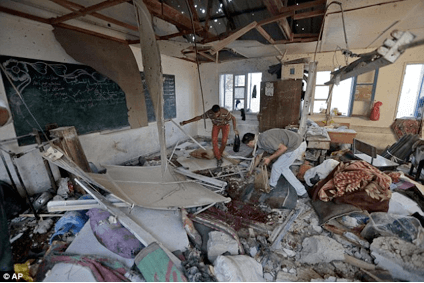
Photo 1. Blast effects of a tank projectile on a school in Gaza, July 2014 (photo credit: The Associated Press ).
Tanks are mobile, armoured, heavy weapons platforms that have been used in the majority of conflicts since World War II. Tanks differ from the other land-based weapon systems examined in this series of studies by employing primarily direct-fire weapons; when firing its main gun, the gunner can see its target and aims directly at it, rather than firing at an indirect trajectory. Although technological advances have ensured modern tanks far exceed the performance of their predecessors, simultaneous advances in anti-tank systems have meant that most remain vulnerable to both conventional military forces and non-state actors employing asymmetric warfare techniques.
This report covers tank guns of 115 mm, 120 mm, and 125 mm in calibre, which encompasses the majority of tank guns that have been produced since 1961, when the Soviet Union introduced the T-62 main battle tank (MBT). It is necessary to limit the scope of this study, and the increase of Soviet tank gun calibres from 100 mm to 120 mm in 1961 provides an appropriate cut-off point in time. Although the T-62 partially replaced the earlier T-55 model with its 100 mm main gun, T-55 tanks remain commonly encountered today. While HE and HE-FRAG ammunition does exist for tank guns, these are more commonly used by tank guns of Russian design. The majority of tank gun ammunition employed by modern militaries is dual-purpose in nature, designed to destroy enemy armoured fighting vehicles, whilst also offering a fragmentation effect for use in an anti-personnel role.
Tanks often take on a high-profile role in modern conflicts. Capable of very high precision in their direct fire role, tanks have nonetheless been involved extensively in attacks within populated areas.
TANK GUNS
The majority of modern tanks are fitted with smoothbore guns, which do not utilise rifled barrels in order to impart spin to projectiles as they are fired (see Annex B). A notable exception is the British Challenger 2 tank, which uses the 120 mm L30 rifled gun. Unlike many other militaries’ armoured units, the British Army continue to use a rifled gun, as their primary tank ammunition is of the high explosive squash-head (HESH) type. HESH ammunition is used both as a general-purpose high explosive projectile, and also against other tanks and armoured vehicles. When HESH ammunition is fired from a rifled barrel, spin imparted to the projectile helps ensure a predictable distribution of the plasticised explosive filler, and thus maximises its efficiency in the anti-tank role. The smoothbore design of most modern tank barrels makes it easier for tanks to fire missiles through the same barrel used to fire projectiles.
The gun itself is not the sole factor influencing the range of a tank during combat operations. Weapons may have both a ‘maximum range’, the farthest that a projectile will travel under optimal conditions, and an ‘effective range’. The definition of the latter varies by user, but is generally considered to be the maximum distance at which a weapon may be expected to be accurate and achieve the desired effect (DoD, 2016). The effective range should only be considered indicative. It varies with ammunition, training, sights used, whether the weapon platform is stable or mobile, weather conditions and other factors. For example, the Russian 115 mm 2A20 Molot tank gun fitted with the TSHS-41U telescopic sight and firing the 3OF18 HE-FRAG projectile has an effective range of 3000 m. At night, firing with the TPN-1 night sight, it is 800 m for all projectile types – a limitation of the sight, not the ammunition. However, the maximum range of the 3OF18 projectile at all times is 9500 m when fired at a gun angle of 16° (Nikolskiy, 1997).
The German Rheinmetall 120 mm smoothbore gun is fitted to the German Leopard 2 tank and to the American Abrams. It can also be found on tanks produced by Japan, South Korea, and Turkey. Owing to the widespread adoption of both the Leopard 2 and the Abrams, the Rheinmetall 120 mm gun is the most widely used weapon system in its class. This gun comes in two versions – the shorter L44, and the longer L55. Both versions can fire the same types of ammunition, the difference being that the longer L55 allows ammunition to generate a higher velocity, which can lead to better performance against other tanks for certain ammunition types (Rheinmetall Defence, 2016).
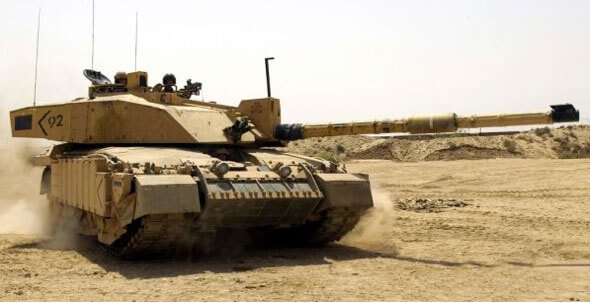
Photo 2. British 120 mm L30A1 tank gun mounted on Challenger 2 (photo credit: Graeme Main, licensed under the Open Government Licence v1.0).

Figure 1. 120 mm smoothbore tank guns (image credit: Thai Military and Asian Region).
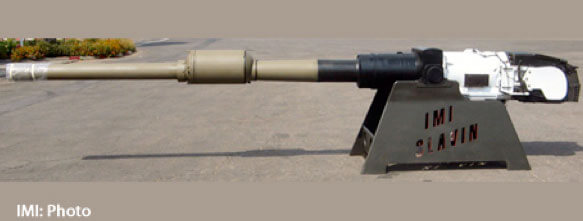
Photo 3. The Israeli Military Industries (IMI) 120 mm L44 MG251/3 smoothbore gun (photo credit: IMI).
The Russian-designed 115 mm 2A20 Molot gun is fitted to the T-62 tank, introduced into service in 1962. This was the first smoothbore gun to be fitted to a tank (Tucker, 2004)). It can fire the 3OF18 HE-FRAG projectile out to an effective range of 3,000 m (Nikolskiy, 1997). This tank has been operated by numerous countries (IISS, 2016), and despite its relative age, it is still used by many armed forces.
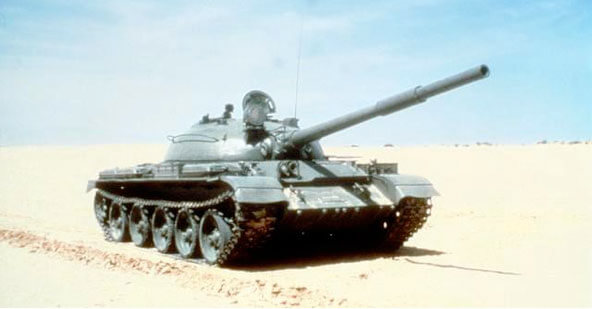
Photo 4. A Russian T-62 tank fitted with the 115 mm main gun (photo credit: The Federation of American Scientists).
The Russian 125 mm 2A46 (D-81) smoothbore gun has been widely adopted on Russian-designed tanks and their foreign copies and derivatives. Versions of this gun have been in use since 1964, and even some of the T-55 tanks, which were first introduced into service in 1958, have been retrofitted with this gun during modernisation programmes in Ukraine and China (Lavrov, 2016). The 2A46 has been updated since its introduction; its more modern version has been given the designation 2A46M-5, but both versions are very similar.
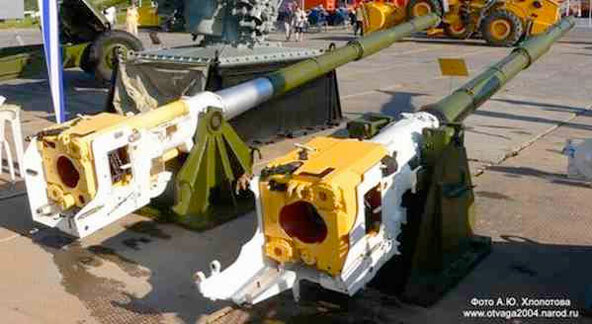
Photo 5. The Russian 125 mm 2A75 tank gun (left), and the 2A46M-5 (right) (photo credit: Otvaga2004).
HIGH EXPLOSIVE TANK GUN AMMUNITION
Tank guns can typically fire a range of different projectiles, most commonly including anti-armour and multipurpose types, the latter used to engage light vehicles, personnel, and fortifications. Anti-armour warheads may be either chemical energy penetrators, or kinetic energy penetrators. The latter type is most commonly shaped like a dart or small-calibre rifle projectile, and are generally non-explosive (Cross et al., 2016). These are not examined in this study. Chemical energy penetrators rely on the energy of an explosive detonation generated when the munition functions on approaching or reaching its target (Meyers, 1994). Examples include shaped charge warheads (including high explosive anti-tank, or HEAT, and explosively formed penetrator, or EFP), high explosive squash-head (HESH) warheads, and other types. As these do not typically have wide-area effects relevant to their use in populated areas, they are not considered further in this study.
High explosive or multi-purpose tank gun ammunition consists, at its simplest, of a high explosive charge packed into a thick casing, typically constructed of hardened steel, a fuze, and (typically), a cartridge case containing propellant. The steel munition body serves two functions: firstly, it ensures that the ammunition is robust enough to withstand the intense forces it is subjected to during firing and whilst in flight; secondly, when the explosive fill detonates, it provides the primary fragmentation effect. Different types of projectile bodies use different types of steel alloys. Some modern projectiles use steel that has not been heat-treated, because it has been found that this type of steel shatters into smaller and more regular fragments than other types of steel, thus increasing the lethal area of the projectile for the same weight of ammunition.
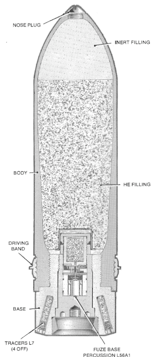
Figure 2. Illustration showing the rounded head and thin sides of a HESH projectile (image credit: British MoD).
Regardless of whether a projectile is fired from rifled or smoothbore barrels, it must fit snugly inside the gun barrel to ensure that there is no movement along the axis of fire. Projectiles fired from rifled barrels have a soft metal driving band fitted towards the rear of the parallel-sided section of the projectile, which prevents any movement in the bore. Most projectiles are also stabilised in the barrel by an almost-imperceptible, slightly raised band towards the front of the parallel-sided section. This is called a bourrelet. The combination of the bourrelet and the driving band keeps the projectile seated inside the barrel both before, and during, firing. The soft metal of the driving band is forced against the hard metal rifling lands along the inside of the barrel. The metal of the driving band then conforms to the hard metal grooves, which results in the projectile being made to spin as it is fired (Goad & Halsey, 1982).
Projectiles fired from smoothbore barrels lack a driving band at the rear, but do require an obturating band to provide both an effective gas seal, and as a means to stabilise and centre the projectile in the barrel (Goad & Halsey, 1982).
Each projectile is fitted with a fuze, either at time of manufacture or, more commonly, prior to firing. The fuze must serve three functions: 1) ensuring a munition can be safely handled during the loading process and in transit; 2) arming the munition at a given time or position; and 3) ensuring the munition functions at a given time or position (Dullum et al. 2016; King, 2011). HE projectiles are most often fitted with impact fuzes, but may occasionally be fitted with a proximity fuze that detonates the munition at a pre-determined distance from the target.
Many modern fuzes are multi-function types, allowing the required mode of operation to be selected immediately prior to firing. When using conventional fuzes, the correct type of fuze needs to be selected and fitted before loading. If the type of target changes, older fuzes may need to be removed and replaced by a different type, but more modern fuzes can simply be reprogrammed.
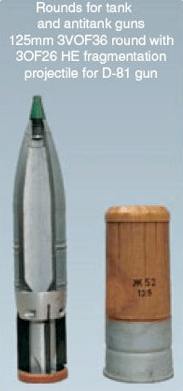
Figure 3. A Russian 125 mm high explosive projectile (and separate propelling charge) that is designed to be fired from the D-81 (2A46) tank gun (image credit: Russian Federal State Unitary Enterprise Mechanical Engineering Research Institute).
TANK GUN CASE STUDIES
More than twenty cases where studied where tank guns were involved. Five case studies were selected for this report on the basis of the confirmed use of these weapons, the accuracy of documentation, and to geographical distribution of conflicts across the weapons studies. These cover the period from October 1999 to July 2014, and the following countries and territories: Russia, Libya and Palestine. The research project continues to monitor documented incidents of use of tank guns from a technical perspective, and may add further case studies in the future.
Table 1 –Case Studies for 115-125 mm Tank Guns
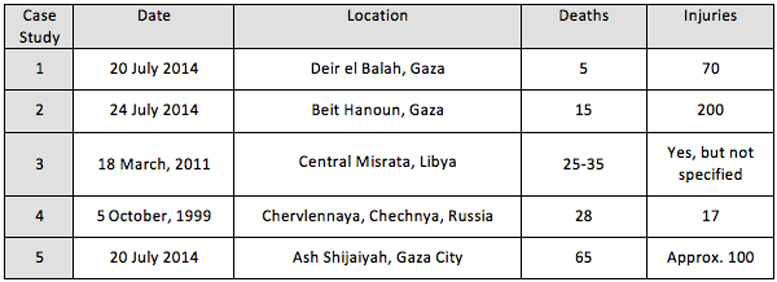
BRIEF DESCRIPTIONS
Case Study No 1
Deir el Balah, Gaza 20 July 2014
On 20 July 2014, the Al Aqsa Martyrs Hospital was attacked by tanks. Reports vary as to the exact number of projectiles that hit the hospital, but there appears to have been a minimum of three, and a maximum of twelve, 120 mm projectiles fired from Merkava tanks. As a result of the attack, five people were killed and more than seventy injured. Two ambulances that attempted to move the injured to another hospital were also destroyed. The firing also damaged the X-ray facilities, the maternity ward, the intensive care unit and the surgical department. Several operating rooms, as well as key equipment, including hospital beds and medical supplies, were destroyed. An oxygen production unit, which is used in a wide range of operations and procedures, was also destroyed.
Case Study No 2
Beit Hanoun, Gaza, 24 July 2014, 15:00
At 15:00, on the afternoon of 24 July 2014, between four and five tank projectiles hit the UN school in Beit Hanoun. At the time, it was being used as temporary refugee shelter, hence crowded with people. It is estimated that up to 1,500 people were inside the structure at the time of the attack. The tank projectiles were 120 mm projectiles fired from Merkava tanks. Fifteen people were killed, and two hundred injured in this attack. Some of the casualties were caused by collapsing ceilings. Many of those injured suffered amputations, allegedly caused by fragmentation.
Case Study No 3
Central Misrata, Libya, 18 March, 2011, 07:00
At 07:00, on 18 March 2011, T-72 tanks attacked the central area of Misrata. The attack was centred on Tripoli Street. It is reported that between 25 and 35 people, including children, were killed during this attack. Unsubstantiated eyewitness reports mention seeing between 20 and 40 tanks. It is not clear exactly how many projectiles were fired during the attack, but substantial infrastructural damage was caused. Mosques, schools, homes and a hospital were all damaged during the fighting, with reports that the hospital was abandoned as a result of the damage it sustained.
Case Study No 4
Chervlennaya, Chechnya, Russia 5 October, 1999, 14:00
At 14:00, on 5 October 1999, a bus containing displaced people was hit by a single tank projectile fired from a T-90 tank. The passengers on the bus were attempting to return to their homes, after having been displaced to Grozny during recent fighting. Reports vary as to the exact number of people who were on the bus, but it would appear that 28 of them were killed and another 17 were injured. Chervlennaya is cited as ‘Chervlyonnaya’ in reports.
Case Study No 5
Ash Shijaiyah, Gaza City, 20 July 2014, throughout the evening.
On the evening of 20 July 2014, tanks began firing into the Ash Shijaiyah area of Gaza City. The attack lasted several hours and resulted in 65 deaths, with reports of one hundred injured. The ICRC reported that dozens of homes over several blocks were destroyed or badly damaged. The ICRC rescued people from collapsed buildings.
CASE STUDIES
CASE STUDY 1
Date/time of attack:
21 July 2014, unknown time.
Location:
Al Aqsa Martyrs Hospital, Deir el Balah, Gaza.
Map of the area:
See Figure 4
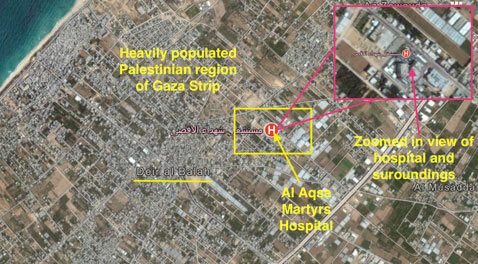
Figure 4. The area around the Al Aqsa Martyrs Hospital, Deir el Balah, Gaza (image credit: Google Maps).
Weapon system:
120 mm tank gun, reportedly Merkava tanks.
Number of projectiles fired:
Between 3 and 12 projectiles fired (reports vary on the exact number).
Range projectiles fired from:
The exact range is unknown.
Estimated impact area:
See Figure 4 – the main area impacted was the hospital itself. There were also reports of projectiles landing in an empty lot near the hospital.
Casualties/Injured:
5 killed and more than 70 injured.
Damage:
There was significant damage done to the hospital during this attack (see infrastructure damage for details). Two ambulances trying to move the wounded to Shifa hospital, in Gaza City, were then also hit. The shelling destroyed beds and important medical equipment.
Infrastructure damage:
There was substantial infrastructure damage to the hospital (see Photos 6 to 9). The third and fourth floors, the reception area, and the upper floor were all badly damaged – one report concluded that the third and fourth floors were completely destroyed. Several exterior walls of the hospital were damaged. The attack also damaged the X-ray facilities, the maternity ward, the intensive care unit, and the surgery department. Several operating rooms, key equipment including hospital beds, and medical supplies were destroyed. An oxygen production unit, which is used in a wide range of operations and procedures, was also destroyed.
Remarks: The attack did not only kill and injure patients in the hospital; approximately 30 of those injured were medical staff working at the hospital at the time.
One report cited Aqsa hospital in central Gaza as one of the only hospitals providing services to several refugee camps, including al-Maghazi and al-Nuseirat, as well as towns and villages including Deir el Balah and Juhu al-Dik, which severely impeded access to medical treatment for the injured.
Photos of Damage:
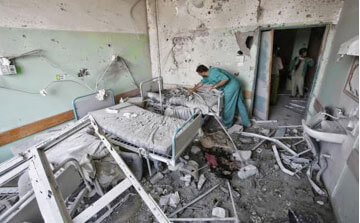
Photo 6. Picking through the rubble at the Al Aqsa Martyrs Hospital, Deir el Balah, Gaza. (photo credit: Sky News).
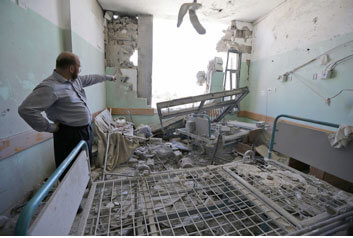
Photo 7. Structural damage at the Al Aqsa Martyrs Hospital, Deir el Balah, Gaza. (photo credit: AP).
Source(s):
- Al Jazeera: http://www.aljazeera.com/news/middleeast/2014/07/deaths-as-israeli-tanks-shell-gaza-hospital-2014721124111171397.html
- The Independent: http://www.independent.co.uk/news/world/middle-east/israel-gaza-conflict-tanks-shell-gaza-hospital-killing-four-and-wounding-30-medical-staff-as-seven-9619055.html
- Middle East Eye: http://www.middleeasteye.net/news/al-aqsa-hospital-hit-strikes-gazas-medical-facilities-continue-1701468997
The Wall Street Journal: http://www.wsj.com/articles/gaza-hospital-attack-caught-civilians-in-crossfire-1406158568
Note: some sources also include video/news reporting of incident.
CASE STUDY 2
Date/time of attack:
24 July 2014, at approximately 15:00.
Location:
UN School/Camp in Beit Hanoun, Gaza City.
Map of the area:
Unable to find exact location of where in Beit Hanoun the school was located. Figure 4 marks the general Beit Hanoun location within Gaza as “a built-up area”.
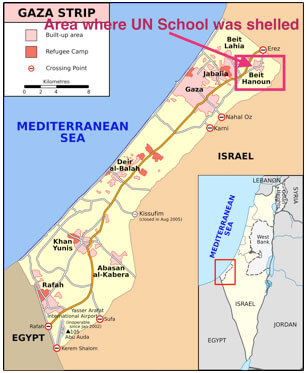
Figure 5. Map of Beit Hanoun, Gaza (image credit: Creative Commons).
Weapon system:
120 mm tank gun, reportedly one Merkava battle tank.
Number of projectiles fired:
Four to five tank projectiles.
Casualties/Injured:
15 killed, over 200 injured.
Damage:
Major damage was caused to a UN school from multiple tank projectiles (see Photos 10-13 for infrastructure damage). At the edge of the schoolyard, some 20 donkeys lay dead, still tied to the railings. According to one report, primary fragmentation was widespread across the area, resulting in many amputations.
Infrastructure damage:
The school itself was very badly damaged (see Photos 10-12). It is reported that an entire classroom collapsed on the people who were inside. One projectile created a large hole in the ceiling of a second-floor classroom. Several ceilings collapsed throughout the school.
Remarks: The school was a UN-managed refugee centre, which was housing close to 1,500 people when it was attacked. According to survivors, one projectile landed in the schoolyard, followed by several more rounds that hit the upper stories of the building.
Photos of Damage:

Photo 10. Structural damage to the UN school/refugee camp in Beit Hanoun, Gaza City (photo credit: AP).
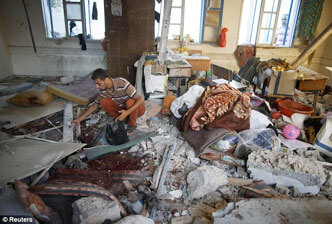
Photo 11. A man picks through the rubble in the UN school/refugee camp in Beit Hanoun, Gaza City (photo credit: Reuters).

Photo 12. A crowd looks in at the damage to the UN school/refugee camp in Beit Hanoun, Gaza City (photo credit: Reuters).

Photo 13. An impact point at the UN school/refugee camp in Beit Hanoun, Gaza City (photo credit: Reuters).
Source(s):
- International Business Times: http://www.ibtimes.co.uk/gaza-strip-massacre-un-school-powerful-photos-israeli-tank-shell-attack-palestinian-1458205
- The Independent: http://www.independent.co.uk/news/world/middle-east/israel-gaza-conflict-un-school-shelled-by-israeli-tanks-leaving-15-dead-and-200-wounded-9626621.html
- The Daily Mail UK: http://www.dailymail.co.uk/news/article-2711444/U-S-condemns-Israeli-aggression-tank-attack-kills-15-men-women-children-asleep-UN-school-refuge.html
- The Guardian: http://www.theguardian.com/world/2014/jul/24/israeli-strike-un-school-gaza-kills-women-children
CASE STUDY 3
Date/time of attack:
18 March 2011, 07:00
Location:
Central Misrata, Libya
Map of the area:
See Figure 6

Figure 6. Map of Central Misrata, Libya (image credit: Creative Commons).
Weapon system:
125 mm tank guns, reportedly Russian-made T-72 battle tanks.
Range projectile fired from:
Unknown, but assumed close range (within city borders).
Estimated impact area:
Unknown.
Casualties/Injured:
25-35 deaths reported, including children.
Damage:
See ‘Infrastructure damage’.
Infrastructure damage:
Shells hit several mosques, schools, and residential buildings. According to one report, a hospital in the city was badly damaged during the fighting. Scenes in one video show glass, rubble, and wrecked medical equipment littering the floors of the abandoned medical facility. A gaping hole is seen in one of the hospital’s walls.
Remarks:
Several reports indicate that many of the dead and injured were children and other civilians. One eyewitness claimed there were at least 20 tanks in the city. Other reports cited as many as 40 tanks entering Misrata that day. In the weeks leading up to the event, Gaddafi’s forces had repeatedly attacked Misrata – water supplies were cut off, there were frequent power cuts, and communications were frequently down.
Photos of Damage: Misrata came under heavy fire throughout the final months of the Gaddafi regime, thus it is not possible to determine exactly what structural damage was caused in the attack on 18 March, and what may have already existed.
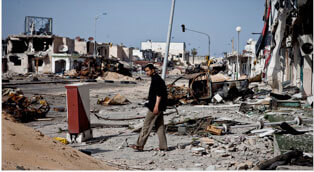
Photo 14. A man walks through the damage on Tripoli Street, Misrata, Libya (photo credit: The Telegraph).

Photo 14. A man walks through the damage on Tripoli Street, Misrata, Libya (photo credit: The Telegraph).

Photo 16. A damaged tank on Tripoli Street, Misrata, Libya (photo credit: The Daily Mail).
Source(s):
- Reuters UK: http://uk.reuters.com/article/2011/03/18/us-libya-misrata-bombard-idUKTRE72H4L520110318
- Fox News: http://www.foxnews.com/world/2011/03/18/libya-fm-declares-immediate-halt-military-action-anti-government-forces/
- Reuters: http://in.reuters.com/article/2011/03/18/idINIndia-55695920110318
- Democratic Underground: http://www.democraticunderground.com/discuss/duboard.php?az=view_all&address=102×4776859
- The Telegraph: http://www.telegraph.co.uk/news/worldnews/africaandindianocean/libya/8405273/Libya-Misurata-hospital-damaged-in-fighting.html
CASE STUDY 4
Date/time of attack:
5 October 1999, 14:00.
Location:
Chervlennaya (cited as “Chervlyonnaya”), Chechnya Russia.
Map of the area:
See Figure 7

Figure 7. Map of Chervlennaya (cited as “Chervlyonnaya”), Chechnya Russia (image credit: Google Maps).
Weapon system:
125 mm tank gun, Russian-made battle tank of an unspecified model.
Number of projectiles fired:
Reports point to only one projectile hitting the bus.
Casualties/Injured:
Exact casualties varied from report to report, but there seems to have been at least 45 civilians (mostly women and children) on the bus when it was hit. The most commonly cited number of those killed was 28, with approximately 17 people being injured.
Damage:
The majority of the damage was to the bus itself. According to reports, it was completely wrecked, torn into two pieces and almost completely burned.
Infrastructure damage:
No reports of infrastructure damage.
Remarks:
One survivor reported to the NY Times that “It was 2:00 p.m. and we went over the Terek River and turned toward Chervlyonnaya when they started to fire. The bus turned back, and suddenly we were hit from behind.”
Source(s):
- New Strait Times: https://news.google.com/newspapers?nid=1309&dat=19991007&id=cOROAAAAIBAJ&sjid=fxQEAAAAIBAJ&pg=4758,2506938&hl=en
- The Guardian: http://www.theguardian.com/world/1999/oct/08/russia.chechnya
- Chicago Tribune: http://articles.chicagotribune.com/1999-10-08/news/9910080389_1_grozny-series-of-apartment-bombings-russian-forces
- CBS News: http://www.cbsnews.com/news/chechnya-pleads-for-peace/
- Human Rights Watch: https://www.hrw.org/legacy/backgrounder/eca/chechnya0403/3.htm
Relief Web: http://reliefweb.int/report/russian-federation/russia-officials-deny-attacking-refugee-bus-chechnya
CASE STUDY 5
Date/time of attack:
20 July 2014, throughout the evening.
Location:
Ash Shijaiyah, Gaza City.
Map of the area:
See Figure 8
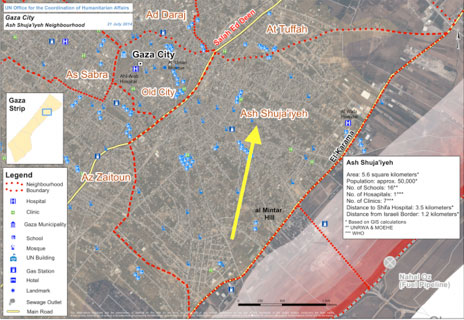
Figure 8. Map of Ash Shijaiyah, Gaza City (image credit:UN OCHA).
Weapon system:
120 mm tank gun, Merkava battle tank.
Number of projectiles fired:
As this incident happened over a period of hours, it is not possible to determine the exact number of projectiles fired.
Casualties:
65 people killed, reports of 100 injured.
Damage:
Reports indicate that during this particular attack residential homes were hit, leading to considerable infrastructure damage to homes and shelters.
Infrastructure damage:
Dozens of houses over several blocks were destroyed or badly damaged. The ICRC reported that they rescued 11 civilians from the rubble.
Remarks:
On the night of 20 July, around midnight, tanks arrived at the edge of the Shijaiyah neighbourhood prior to hours of firing taking place. “In Shijaiyah, the heavy shelling began around midnight as tanks reached the edge of the neighbourhood”, residents said.
This particular attack in Gaza displaced thousands of refugees, who were living in Shijaiyah. While Gaza’s health minister claimed that more than 35,000 were displaced during this one day, UNOCHA reported that half of the town’s population of 92,000 had fled to Gaza City because of the fighting.
Photos of Damage:

Photo 17. Destroyed buildings in Ash Shijaiyah, Gaza City (photo credit: The Atlantic).
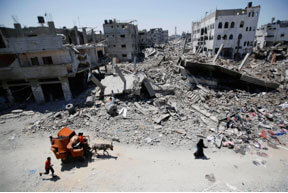
Photo 18. Buildings reduced to rubble on the streets of Ash Shijaiyah, Gaza City (photo credit: AP).
Source(s):
- The Daily Mail: http://www.dailymail.co.uk/news/article-2698878/Indiscriminate-bloodshed-continues-Gaza-20-Palestinians-killed-Israeli-shelling-hospitals-overflow-women-children.html
- Seattle Times: http://o.www.seattletimes.com/nation-world/panicked-residents-flee-israeli-tank-fire-on-gaza/
- Portland Press Herald: http://www.pressherald.com/2014/07/20/israel-escalates-ground-offensive-in-gaza/
- Central Maine: http://www.centralmaine.com/2014/07/20/israel-escalates-ground-offensive-in-gaza/
- The Atlantic: http://www.theatlantic.com/photo/2014/07/bloody-weekend-in-gaza/100778/
- UN Office for Coordinating Humanitarian Affairs (OCHA): https://www.ochaopt.org/documents/ocha_opt_sitrep_21_07_2014.pdf
- ICRC Article 25 July 2014: https://www.icrc.org/eng/resources/documents/article/editorial/07-24-gaza-israel-palestine-maio.htm
